

Chatbots Helping in Suicide Prevention. For all of these suicide deaths, there are five individuals hospitalized following self-damage, 25 to 30 suicide endeavors and seven to 10 individuals impacted by every disaster, as indicated by an analysis carried by the Public Health Agency of Canada.

Suicide rates are most elevated among specific gatherings, for example, Indigenous people groups, settlers and displaced people, detainees and the lesbian, gay, bisexual, transgender, intersex (LGBTI) people group are on the ascent. DARPA Wants Brain Implants For Restoring Memories. The U.S.

Department of Defense is spending $40 million to develop implantable devices to restore memories in people suffering from trauma and neurological disorders. More than 270,000 military servicemembers have been diagnosed with traumatic brain injury since 2000, and 1.7 million U.S. civilians are affected every year. The goal is to develop wireless neuroprosthetics to bridge the gaps that interfere with the ability to form new memories or retrieve old ones, the Defense Advanced Research Projects Agency (DARPA) announced this week. To that end, teams from the University of California, Los Angeles, and the University of Pennsylvania were selected to begin leading the agency’s Restoring Active Memory (RAM) program, part of President Obama’s BRAIN Initiative.
They’ll receive up to $15 million and $22.5 million, respectively, over four years to develop and test electronic interfaces that not only sense memory deficient but also restore normal function. Image: DARPA. Direct Brain-To-Brain Communication Used in Humans. Tapping directly into someone’s brain in order to share thoughts isn’t just for Spock anymore.

An international team of researchers were able to replicate the Vulcan Mind Meld by creating a device that allows two people to share information through thought. The researchers tested the technology by separating the users over 8,000 km (5,000 mi) apart—with one user in France and the other in India. The paper has been published in PLOS ONE. "We wanted to find out if one could communicate directly between two people by reading out the brain activity from one person and injecting brain activity into the second person, and do so across great physical distances by leveraging existing communication pathways," co-author Alvaro Pascual-Leone said in a press release.
Serotonin Deficient Brains More Vulnerable to Social Stress. Mice provide clues for alleviating treatment-resistant depression.
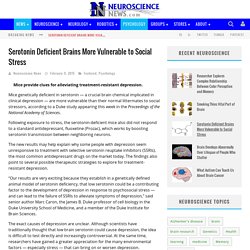
Mice genetically deficient in serotonin — a crucial brain chemical implicated in clinical depression — are more vulnerable than their normal littermates to social stressors, according to a Duke study appearing this week in the Proceedings of the National Academy of Sciences. What has neuroscience ever done for us? Mental health problems exert an enormous social and economic burden.

By way of example, the cost of depression alone to the British economy is over £9 billion annually (Thomas & Morris, 2003), and more than twice as many people die from suicide each year in the UK than are killed on its roads (Office for National Statistics). These stark figures are surprising given that depression is treatable, with strong evidence supporting both pharmacological and psychological interventions.
Oxytocin Enhances Pleasure of Social Interactions by Stimulating Production of “Bliss Molecule” UCI study uncovers role of oxytocin in triggering marijuana-like neurotransmitters.
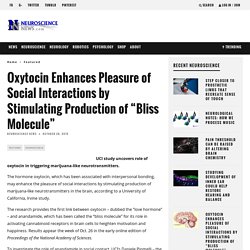
The hormone oxytocin, which has been associated with interpersonal bonding, may enhance the pleasure of social interactions by stimulating production of marijuana-like neurotransmitters in the brain, according to a University of California, Irvine study. The research provides the first link between oxytocin – dubbed the “love hormone” – and anandamide, which has been called the “bliss molecule” for its role in activating cannabinoid receptors in brain cells to heighten motivation and happiness.
Results appear the week of Oct. 26 in the early online edition of Proceedings of the National Academy of Sciences. Serotonin Deficient Brains More Vulnerable to Social Stress. The Coming Boom In Brain Medicines. New Study Shows That Your Brain's Powers Change As You Age. What has neuroscience ever done for us? Scientist: Most complete human brain model to date is a ‘brain changer’ COLUMBUS, Ohio – Scientists at The Ohio State University have developed a nearly complete human brain in a dish that equals the brain maturity of a 5-week-old fetus.
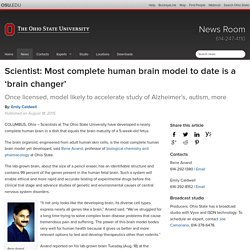
The brain organoid, engineered from adult human skin cells, is the most complete human brain model yet developed, said Rene Anand, professor of biological chemistry and pharmacology at Ohio State. The lab-grown brain, about the size of a pencil eraser, has an identifiable structure and contains 99 percent of the genes present in the human fetal brain. Such a system will enable ethical and more rapid and accurate testing of experimental drugs before the clinical trial stage and advance studies of genetic and environmental causes of central nervous system disorders. “It not only looks like the developing brain, its diverse cell types express nearly all genes like a brain,” Anand said.
“We’ve struggled for a long time trying to solve complex brain disease problems that cause tremendous pain and suffering. Related images. It took 12 weeks to grow this tiny brain in a petri dish. It could revolutionize neuroscience. Imagine a brain ravaged by neurological disease.
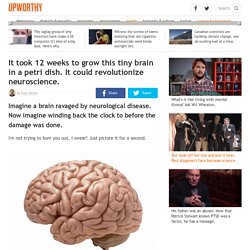
Now imagine winding back the clock to before the damage was done. I'm not trying to bum you out, I swear! Just picture it for a second. Not much to look at, is it? Photo by DJ_/Flickr. What if you knew that a person — or their brain, specifically — was almost guaranteed to develop a serious disease? Depression: It’s Not Your Serotonin. Oxytocin Enhances Pleasure of Social Interactions by Stimulating Production of “Bliss Molecule” Researchers Reprogram Genome to Produce More Dopamine.
In Brief Researchers found a gatekeeper protein that, when inhibited, allows for the transformation of skin cells into dopamine neurons.

The Gatekeeper Parkinson’s disease researchers from the Jacobs School of Medicine and Biomedical Sciences at the University of Buffalo have found a way to boost the conversion of skin cells into neurons that produce dopamine. This Startup Gets You High On Dopamine, No Exercise Required. All of the Fun, None of the Workout If you think about it, every company exhibiting at CES is trying to sell the same thing: happiness.
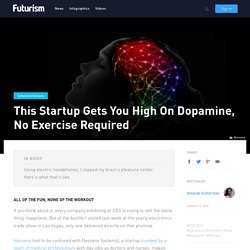
A Different Path to Fighting Addiction. Photo. Ernesto Sirolli: Want to help someone? Shut up and listen! How Addiction Works, and What You Can Do About It. A tiny area of the brain may enable consciousness, says "exhilarating" study. This brain circuit works as a sort-of “engine for consciousness,” the researchers say, enabling conscious thought and feeling in primates. From recognition to transformation: How digital technology can reduce mental illness stigma. When those with mental illness experience prejudice and discrimination in the form of stigma, it can make their suffering considerably worse. Spreading awareness and understanding through education is one of the strategies used to tackle the problem. Years of public education campaigns have helped open the conversation. Yet evidence suggests that stigma against people with mental illness remains a problem in our health-care system. Consider what the experience is like for a young person who seeks mental-health care.
They may suffer for a long time before they eventually build up the courage to ask for help. The doctor, nurse or mental health professional they encounter is probably struggling within a challenging system.